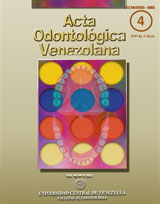PREVALENCIA DE CARIES DENTAL EN LA POBLACIÓN INFANTIL QUE ACUDEN AL AMBULATORIO URBANO "LA HACIENDITA" EN EL MUNICIPIO MARIARA, ESTADO CARABOBO
Palabras clave:
prevalencia, caries dental, salud, educación, prevalence, dental decay, healthResumen
La caries dental en los seres humanos es una enfermedad crónica, compleja, dinámica, infecciosa y de origen multifactorial. Este estudio tuvo como objetivo determinar la prevalencia de caries dental con relación al sexo y la edad en un grupo de niños y niñas atendidos en el Ambulatorio "La Haciendita", en el Municipio Mariara, Edo. Carabobo. El tipo de investigación fue cuantitativa de diseño descriptiva no experimental transeccional. La población y muestra estuvo conformada por 30 niños (100%) entre 6 a 12 años que asistieron a la consulta odontológica del ambulatorio, en un lapso de 3 meses. El instrumento fue una historia clínica elaborada en base a las dimensiones de las variables del estudio, validada por juicio de expertos. Los resultados según sexo y edad fueron 63,66% niñas y 36,66% niños. El 76,6% tenían edades comprendidas entre 6 y 10 años y sólo el 23,3% tenían edades entre 11 a 12 años. La prevalencia de caries en dentición permanente de todos los niños fue 13,22% y en dentición temporal fue de 20,94%. Se obtuvo un índice del promedio de dientes cariados, perdidos, obturados (CPOD) de 2,46 y un promedio de dientes temporarios cariados (c), con extracción indicada (e) y obturados en una población (ceo) de 1,96. De igual manera se identificó el componente cariado como el más elevado en ambas denticiones. Se concluye que la alta incidencia de caries dental puede reducirse si modificamos o intervenimos a través de su prevención desde la concepción del niño.
ABSTRACT
The dental decay in humans is a chronic, complex, dynamic, infectious, and multifactorial origin. This study had like objective to determine the prevalence of dental decay in relation to sex and the age in a group of children and children taken care of in Ambulatory "The Haciendita", in the Municipality Mariara, State Carabobo. The type of investigation was quantitative of descriptive design nonexperimental transeccional. The population and shows was conformed by 30 children (100%) enters 6 12 years that attended the odontological consultation of the ambulatory one, a lapse of 3 months. The instrument was an elaborated clinical history on the basis of the dimensions of the variables of the study, validated by judgment of experts. The results according to sex and age were 63.66% children and 36.66% children. 76.6% had ages between 6 and 10 years and only 23.3% had ages between 11 to 12 years. The prevalence of decay in permanent teething of all the children was 13.22% and in temporary teething it was of 20.94%. An index of the average of carious, lost teeth, obturated (DMFT) was obtained of 2,46 and an average of carious temp teeth (c), with indicated extraction (e) and obturated in a population (dmft) of 1,96. Of equal way decayed component was identified as the highest in both dentitions. One concludes that the high incidence of dental decay can be reduced if we modified or we take part through its prevention from the conception of the boy.


